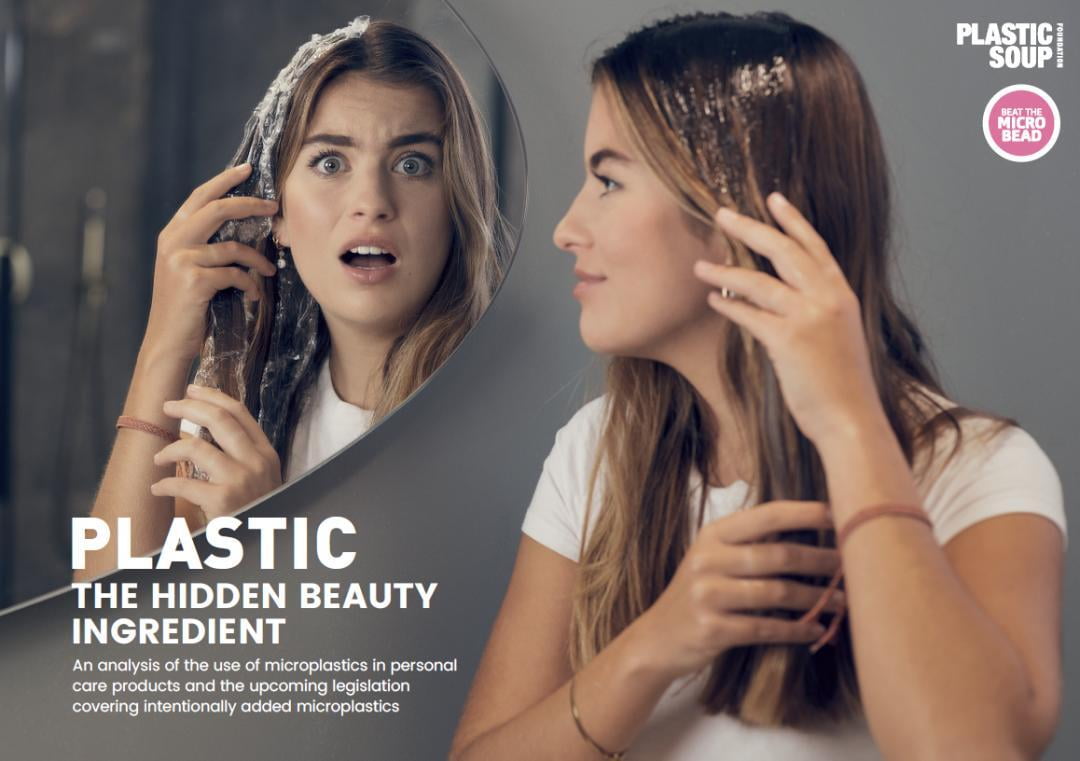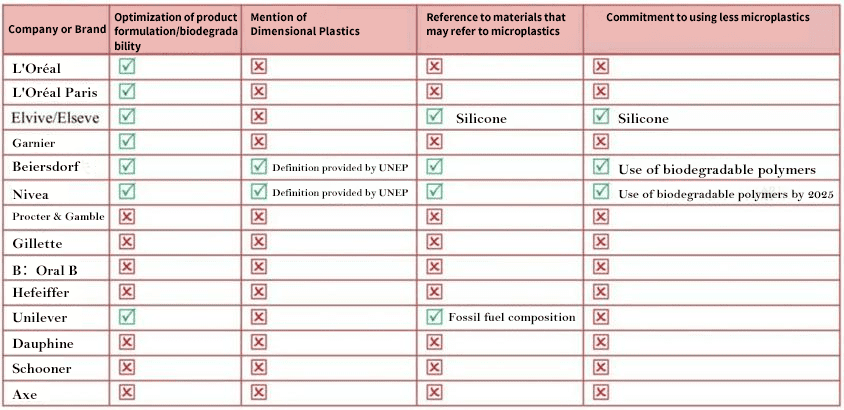Body wash, face wash, shampoo ...... we use every day in the daily chemical products, but hidden microplastics? Recently, the Plastic Soup Foundation released its latest report, "Microplastics - The Hidden Ingredient in Everyday Products" (hereinafter referred to as the report), which analyzes the use of microplastics in the world's top 10 household chemical brands. According to the report, the vast majority of the 10 most representative household brands of the world's 4 largest household groups - L'Oreal, P&G, Unilever and Beiersdorf - contain microplastics in the ingredients of their products.
Biodegradable plastics also remain in the environment
The European Chemicals Agency (ECHA) and the European Commission estimate that the use of daily chemical products results in approximately 3,800 tons of microplastics entering the environment each year. In order to limit the intentional addition of microplastics in household products, the EU is developing a specific proposal for plastic restriction, which will come into force by the end of 2022.
Currently, there is no uniform definition of microplastics. The United Nations Environment Programme (UNEP) defines microplastics as plastic particles that are solid, insoluble in water, no larger than 5 mm in diameter, and not biodegradable. In the plastic restriction proposal, ECHA proposes a smaller definition, ECHA defines microplastics as solid polymers with a diameter between 0.1 microns and 5 mm or a length between 0.3 microns and 15 mm and a length-to-diameter ratio greater than 3.
The report concluded that in the cosmetics industry, microplastics refer to various types of plastic particles that are intentionally added to products. The plastic restriction proposal involves only solid plastic particles, while liquid, semi-solid, water-soluble and nano-plastics are excluded, which the report finds undesirable because these types of plastics also have adverse effects on the environment and human health.
In addition, the report concludes that many methods for assessing the biodegradability of plastics, including those of the OECD and the International Organization for Standardization (ISO), are not sufficiently rigorous. Realistic conditions are more complex than laboratory conditions, and the degradation rate of biodegradable plastics will be lower, so there may still be biodegradable plastics left in the environment. Therefore, the report concluded that biodegradable plastics should also be included in the management of the plastic restriction proposal.

Microplastic use of the top 10 daily chemical brand products
In classifying the microplastic content of household products, the report uses a "traffic light system".
Red means it contains microplastics.
Yellow means it contains "suspected microplastics".
Green means no known or suspected microplastics.
What are the dangers of microplastics? Scientists have found microplastics in the placenta, lungs, and blood of humans. To date, there are no data on the potential adverse effects of microplastics on human health, and their harmful effects on the respiratory system are unknown, but microplastics have been shown to be toxic and harmful to many forms of life in the aquatic environment.
Combining information from brand websites and relevant ingredient data from the Beat the Microbead (BTMB, eliminating plastic microbeads) database software, the report analyzes the use of microplastics and treatment plans for the top 10 household chemical brands.

The report concludes that on the issue of plastic pollution, most brands focus only on packaging and ignore microplastics in product formulations. In addition, the definition of microplastics proposed by ECHA and UNEP does not cover all types of microplastics, which leaves a lot of room for greenwashing by companies. The report recommends that plastic restriction proposals adopt a stricter definition of microplastics to prompt companies and brands to remove all microplastic ingredients and develop truly sustainable formulations.
The following is a specific analysis of the treatment of microplastics for representative products of the four major groups.
L'Oréal Group
In its sustainability plan, L'Oréal did not directly mention microplastics, saying only that they would re-evaluate product formulations by 2030 to ensure that they "respect" aquatic ecosystems, but they did not explain exactly what they meant by the word "respect". L'Oréal hopes that by 2030, 95% of the ingredients in product formulations will be bio-based materials. However, it is important to note that bio-based materials are not the same as eco-friendly or biodegradable materials.
The following are the details of the three L'Oréal Group brands.
L'Oréal Paris: Of the 1003 products included in the BTMB database, 77% contain red microplastics, 90% contain yellow microplastics, and only 4% are green products.
In its sustainability program, L'Oréal Paris does not mention microplastics and product formulations, but focuses on packaging. L'Oréal added that they have adjusted the formulations of their rinse-off products and that exfoliating products have been free of plastic microbeads since January 2017, and that all rinse-off products have been free of microplastics since 2020, with the removal of microplastics from other types of products gradually underway. However, they refer to the definition of microplastics proposed by ECHA, so the report has doubts about the assertion that "all rinse-off products are free of microplastics".
Elvive/Elseve: Of the 374 products in the BTMB database, 53% contained red microplastics, 83% contained yellow microplastics, and only 7% were green products.
In its sustainability program, Elvive alludes to microplastics, stating that with the latest co-emulsification technology, they can use the thinnest microdrop coating to wrap fibers. This not only reduces the use of silicon, but also improves the biodegradability of the formulation.
Elvive's leave-in hair care products are listed as "green innovations", but the report tested 15 such products and found that 11 contained red and yellow microplastics and 3 contained yellow microplastics, with only 1 being green. On balance, the report concluded that Elvive's action plan is more suspicious of "greenwashing".
Garnier: Of the 1,454 products in the BTMB database, 48% contain red microplastics, 67% contain yellow microplastics, and 23% are green products.
Garnier is committed to fighting the environmental pollution of plastic packaging, but has paid little attention to the microplastics in its products.
They say that an average of 91% of formulation ingredients for new toiletries in 2019 will come from biodegradable sources; and hope that by 2025, 75% of formulation ingredients will use bio-based materials. The report re-emphasizes that bio-based materials are not the same as eco-friendly or biodegradable materials.
Beiersdorf Group
Beiersdorf, the parent company of Nivea, said that all of its rinse-off products will be free of microplastics from 2019. They are also working to improve the formulation of the leave-on type products to replace the microplastics used. They also said that Nivea will achieve 100% microplastic-free products by 2022, and Eucerin will do the same by 2024. However, Beiersdorf is referring to the definition of microplastics proposed by UNEP. As mentioned earlier, this definition is not comprehensive.
Beiersdorf mentioned that by 2025, all of its European products will be formulated with ingredients that are 100% biodegradable. In characterizing the biodegradability of the materials, they will use the OECD and ISO methods. The report emphasizes that, as mentioned earlier, these methods do not measure the true biodegradability of the material.
Nivea: Of the 2,789 products in the BTMB database, 62% contain red microplastics, 70% contain yellow microplastics, and 10% are green products. Among them, all of Nivea's Naturally Good line is free of microplastics.
Nivea says that their body wash, shampoo and face wash are formulated to be 100% free of microplastics. In addition, they have completely phased out PE plastic microbeads from their products in 2015 and have begun phasing out shading agents from their rinse-off products. According to the definition of microplastics proposed by UNEP, liquid or gel biodegradable polymers are not considered microplastics, so they plan to use both materials.
P&G Group
In its sustainability program, P&G does not mention microplastics, but does mention green chemistry. The report concludes that the impact on product formulation is unclear, and it is also unclear whether P&G will use less plastic or switch to biodegradable materials.
P&G says it is working to identify which ingredients are more environmentally friendly through a 360% scientific life cycle assessment. In addition, P&G will use the definition of microplastics proposed by ECHA, which indicates that they will not currently handle microplastic ingredients that are outside the scope of the ECHA definition.
Gillette: Of the 115 products included in the BTMB database, 39% contain red microplastics, 90% contain yellow microplastics, and only 6% are green products.
P&G emphasized that Gillette's shaving gel or foam no longer contains PE and PTFE, two types of plastics.
Gillette's sustainability plan does not mention microplastics, stating only that they want to continue to produce high-quality products that are recognized by consumers and scientific organizations, and to improve the transparency of product ingredients.
Oral B: Of the 158 products included in the BTMB database, 49% contain red microplastics, 71% contain yellow microplastics, and 18% are green products.
Oral-B states that its French PureActiv toothpaste formula is 92% natural ingredients, but the report found that the brand's other product formulas contain plastic ingredients. Oral-B's sustainability program does not mention microplastics or even involve packaging improvement plans, but rather focuses on fostering healthy oral care habits and improving transparency of product ingredient information.
Heflex: Of the 324 products included in the BTMB database, 96% contain red microplastics, 90% contain yellow microplastics, and only 1% are green products. Hafele's sustainability program also makes no mention of microplastics, focusing instead on improving packaging and reducing the amount of plastic packaging waste. The report cautions that focusing on plastic packaging alone is not enough to solve the problem of plastic pollution in everyday products.
Unilever
Unilever says it is working to improve the design and formulation of its products. In their sustainability plan, they do not directly mention microplastics, but mention the production of raw materials as fossil fuel components, and say they have launched innovative plans to replace fossil fuel carbon with recyclable or renewable carbon.
Unilever highlighted that some of the microplastic content has been removed from its deodorant products in Europe and that the Group's global efforts to remove microplastics are ongoing. Currently, about 90% of the ingredients in Unilever's daily products are biodegradable; by 2030, they will achieve 100% biodegradable ingredients in their products.
The report concludes that Unilever follows the definition of microplastics as proposed by ECHA and UNEP, and therefore not all microplastics are removed. When assessing the biodegradability of a material, Unilever uses the OECD methodology. As mentioned earlier, this method does not reflect the biodegradability of the material in a real environment.
Dauphin: Of the 1024 products included in the BTMB database, 56% contain red microplastics, 76% contain yellow microplastics, and 16% are green products.
Dove's sustainability program does not address product formulation or microplastics. Their Dutch website mentions that Dauphin began phasing out microbeads in 2014 and also mentions that they are developing sustainable materials, but both lack detailed information and do not provide specific plans to replace fossil fuel-based ingredients with bio-based ones.
Schooner: Of the 166 products included in the BTMB database, 13% contain red microplastics, 92% contain yellow microplastics, and only 8% are green products.
On the issue of sustainability, Schooner has no plans, except to say that they support the work of the Aluminium Packaging Recycling Organisation and the British Aerosol Manufacturers Association, encouraging all UK local authorities to recycle aerosols.
Axe: Of the 297 products included in the BTMB database, 16% contain red microplastics, 57% contain yellow microplastics, and 41% are green products.
Axe does not have a sustainability plan and has not published any quantifiable targets for dealing with plastic pollution. At the end of the company's values page, Axe mentions their environmental program, but it's all about the product packaging rather than the microplastic content of the products.

